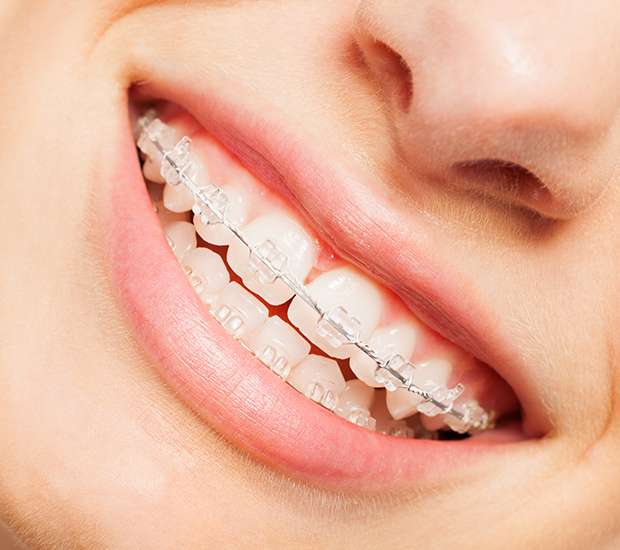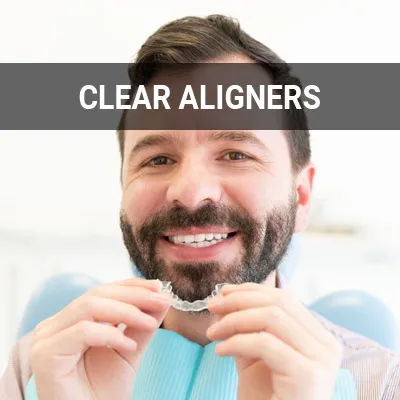Clear Braces Des Plaines, IL
Clear braces are an innovation in dental technology that has given patients a way to straighten teeth less visibly than traditional metal braces. Like metal braces, clear braces can treat misaligned teeth and improve oral health. Clear braces are a type of braces with brackets and wires made of clear or less visible ceramic material.
People with misaligned and crowded teeth can achieve straighter bites and smiles subtly with clear braces. Our team at Apple Family Dental in Des Plaines and the surrounding area can help. Call us today at (847) 553-4848 to schedule an appointment or learn more about our services.
How Clear Braces Work
Clear braces consist of plastic or ceramic brackets glued to each tooth. A wire made from metal or a white material connects the brackets. Over time, the wire pulls the teeth in different directions to straighten them. Researchers in dentistry explain that this movement occurs because of the bone tissue rebuilding process.
Clear braces take around 12 to 36 months to straighten teeth. Clear braces may take longer than metal braces to work because they consist of more fragile materials. The brackets on clear braces are replaced often to prevent breakage from pressure as teeth move. Low-quality ceramic braces can cause the brackets to break, resulting in an extended treatment time.
“Clear braces consist of plastic or ceramic brackets glued to each tooth.”
Candidates For Clear Braces
Clear braces are an option for most patients who can receive traditional braces. The treatment is typically most effective for teens and adults. Children are not good candidates as their mouths are still growing, which can interrupt orthodontic treatment. This movement may cause brackets to break as the ceramic in clear braces is more prone to breaking than metal braces. However, in certain circumstances, a dentist may recommend braces for children to avoid future issues.
Patients who need intensive treatment like additional hardware beyond braces may also not be good candidates for ceramic braces. Severe overbites, underbites, and crossbites may require special treatment that is not available in clear braces systems. A cosmetic dentist can determine whether a patient is a candidate for clear braces.
“Clear braces are an option for most patients who can receive traditional braces.”
Benefits and Drawbacks of Clear Braces
There are benefits and drawbacks to clear braces that candidates should consider. Clear braces provide cosmetic benefits as they are less noticeable on teeth than traditional metal braces. They are less visible because the ceramic material is either tooth-colored or clear. Clear braces work faster than clear aligners, which can take one year or longer to straighten teeth.
Although clear braces are less conspicuous, the material used is more fragile than traditional metal braces. This fragility means a bracket may crack during the process and need replacement. A 2016 study found that clear braces are more than twice as likely to break than metal braces. Another potential drawback is that clear bracket ties can stain easily. Patients should avoid this by brushing and flossing after every meal, avoiding foods and drinks that cause discoloration, and not smoking or using whitening toothpaste.
“There are benefits and drawbacks to clear braces that candidates should consider.”
Check out what others are saying about our dental services on Yelp: Clear Braces in Des Plaines, IL
The Stages of Getting Clear Braces
People getting clear braces will often make a series of visits to the orthodontist. The purpose of these visits is to determine a treatment plan, place the braces on the patient, and make any necessary adjustments. This process occurs over numerous stages:
- Initial Visit: The orthodontist will do a dental exam, take X-Rays, and discuss the patient’s goals. The orthodontist will develop a treatment plan with this information. During this visit, an impression of the teeth helps with the design of the braces.
- Pre-placement visit:Not everyone will need this appointment. Patients who have excessive crowding may need one or more teeth extracted to make room in the mouth. Before the placement of the braces, patients may need additional periodontal work.
- Placement of the braces: The teeth will be cleaned, conditioned, and primed for the brackets. The impression mold determines the bracket position before cementing them on. We then insert a wire through the brackets.
- Adjustments: Depending on the exact type of clear braces, patients may need to come in for regular adjustments of the wire. The patient will usually visit monthly for the readjustment. The new wire helps to continue the process of moving the teeth. These visits continue until the desired outcome is reached.
“People getting clear braces will often make a series of visits to the orthodontist.”
Questions Answered on This Page
Q. What are the benefits and drawbacks of clear braces?
Q. What are the steps to get clear braces?
Q. Who is a good candidate for clear braces?
Q. What is the difference between clear braces and clear aligners?
People Also Ask
Q. How should people take care of their teeth after a smile makeover?
Q. What are the types of cosmetic treatments?
Q. What types of restorative dental procedures are available?
Differences Between Clear Braces and Other Orthodontic Options
Clear braces and clear aligners both serve as alternatives to traditional metal braces. Each option has its unique benefits and drawbacks that patients should keep in mind. Clear braces work similarly to traditional metal braces but use clear materials to make them more discreet. Clear braces are a highly effective form of orthodontic treatment and can treat most alignment issues that traditional braces can. Clear braces are more effective than clear aligners in severe cases and are often less expensive. Unlike aligners, clear braces are not removable, resulting in continuous treatment.
A drawback of clear aligners is that patients must take out their clear aligners during teeth cleaning and eating. This removability can result in the patient losing or misplacing their aligner, halting treatment until a new set arrives. The new set may take several weeks to come, and teeth may slip back into place during that time. A study in BMC Oral Health found that although clear aligners and braces were both effective in treating malocclusion, clear aligners were not as effective as braces in producing adequate occlusal contacts, controlling teeth torque, and retention. Clear braces are more effective than clear aligners in severe cases and are often less expensive.
“A study in BMC Oral Health found that although clear aligners and braces were both effective in treating malocclusion, clear aligners were not as effective as braces in producing adequate occlusal contacts, controlling teeth torque, and retention.”
Frequently Asked Questions
Q. Should I change what I eat when I have clear braces?
A. Yes, patients should modify their diets while wearing braces of any sort to avoid damage. Patients should avoid hard, sticky, crunchy, and chewy foods, as these are likely to break brackets. Limiting drinks and foods that can stain and discolor is also recommended.
Q. Should I take any precautions before playing a sport?
A. Patients who play sports or engage in other physical activities during treatment should take necessary precautions to prevent potential damage. Patients should wear a mouthguard to protect the braces while playing sports. The mouthguard will prevent any impact from damaging the braces or hurting the inside of the mouth.
Q. What do I need to do after my clear braces treatment is over?
A. Most patients receive retainers after treatment is completed. Retainers are worn at night to help keep the teeth in alignment. It is also important to continue good dental hygiene to protect the teeth.
Q. Will I experience any pain with clear braces?
A. There may be some discomfort during treatment as braces cause the teeth to move. This discomfort is most apparent when the patient first gets them and following wire tightening. However, clear braces' ceramic material is less abrasive to the gums and sides of the mouth than traditional metal braces.
Q. Are clear wire braces completely invisible?
A. No, clear braces are not completely invisible. Even the most subtle orthodontic treatments may be noticeable if someone is looking closely. However, they are distinctly less noticeable than traditional metal braces.
Invisalign® Terminology
Call Us Today
Clear braces are a great way to achieve a beautiful smile without feeling self-conscious about visible braces. Contact Apple Family Dental at 847-553-4848 and learn more about clear braces and whether it is the right tooth straightening option for you.
Helpful Related Links
- American Dental Association (ADA). Glossary of Dental Clinical Terms. 2024
- American Academy of Cosmetic Dentistry® (AACD). Home Page. 2024
- WebMD. WebMD’s Oral Care Guide. 2024
About our business and website security
- Apple Family Dental was established in 1994.
- We accept the following payment methods: American Express, Cash, Check, Discover, MasterCard, and Visa
- We serve patients from the following counties: Cook County and Lake County
- We serve patients from the following cities: Des Plaines, Niles, Glenview, Morton Grove, Park Ridge, Mount Prospect, Northbrook, Wheeling, Skokie, Arlington Heights, Buffalo Grove, Schaumburg, and Prospect Heights
- National Provider Identifier Database (1558090167). View NPI Registry Information
- Norton Safe Web. View Details
- Trend Micro Site Safety Center. View Details
Back to top of Clear Braces











